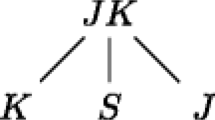Abstract
Triplets of polynomials in four variables with rational coefficients and every term of arbitrarily high degree are exhibited. At least one polynomial in each triplet vanishes on infinitely many integer points whose coordinates are all prime.
Similar content being viewed by others
References
P. Berrizbeitia and P.D.T.A. Elliott, “On products of shifted primes,” The Ramanujan Journal 2 (1998), 201-217.
E. Bombieri, “On the large sieve,” Mathematika 12 (1965), 201-225.
E. Bombieri, J. Friedlander, and H. Iwaniec, “Primes in arithmetic progressions to large moduli,” Acta Math. 156 (1986), 203-251.
J. Chen, “On the representation of a large even integer as the sum of a prime and the product of at most two primes,” Kexue Torgbao 17 (1966), 385-386 (Chinese).
J. Chen, “On the representation of a large even integer as the sum of a prime and the product of at most two primes,” Sci. Sinica 16 (1973), 157-176.
P.D.T.A. Elliott, “On a conjecture of Kátai,” Acta Arithmetica XXVI (1974), 11-20.
P.D.T.A. Elliott, “The multiplicative group of rationals generated by the shifted primes, I,” J. reine und ang. Math. 463 (1995), 169-216.
P.D.T.A. Elliott, “Products of shifted primes. Multiplicative analogues of Goldbach's problems, II,” The Ramanujan Journal 2 (1998), 201-217.
P.D.T.A. Elliott, “The multiplicative group of rationals generated by the shifted primes, II,” J. reine und ang. Math. 519 (2000), 59-71.
P.D.T.A. Elliott, “Primes, products and polynomials,” Inventiones Mathematicae 149 (2002), 453-487.
P.D.T.A. Elliott, “Probabilistic number theory and its ramifications,” RIMS Kokyuroku 1219, Analytic Number Theory-Expectations for the 21th Century, Research Institute for Mathematical Sciences, Kyoto University, Kyoto, Japan, July 2001, 33-50.
H. Halbertstam and H.-E. Richert, Sieve Methods, Academic Press, London, New York, San Francisco, 1974.
P.Kuhn, “ZurViggo Brun'schen Siebmethode, I,” Norski Vid. Setsk. Forth. Trondhjem 14(39) (1941), 145-148.
Chengdong Pan and Chengbaio Pan, Goldbach Conjecture, Science Press, Beijing, China, 1992.
K. Prachar, Primzahlverteilung, Grund. der math.Wiss., Springer-Verlag, Berlin, Göttingen, Heidelberg, 1957.
L.G. Schnirelmann, “On additive properties of numbers,” Rostov, ND, Izv. Donsk. Polytech, in-ta 14 (1930), 3-28; (Russian).
L.G. Schnirelmann, “Ñber additive Eigenschaften von Zahlen,” Math. Ann 107 (1933), 649-690.
G. Tenenbaum, Introduction to Analytic and Probabilistic Number Theory, Cambridge University Press, 1995.
E.C. Titchmarsh, The Theory of the Riemann Zeta Function, Oxford University Press, 1951.
Author information
Authors and Affiliations
Rights and permissions
About this article
Cite this article
Elliott, P. More Primes and Polynomials. The Ramanujan Journal 7, 299–320 (2003). https://doi.org/10.1023/A:1026263616305
Issue Date:
DOI: https://doi.org/10.1023/A:1026263616305



